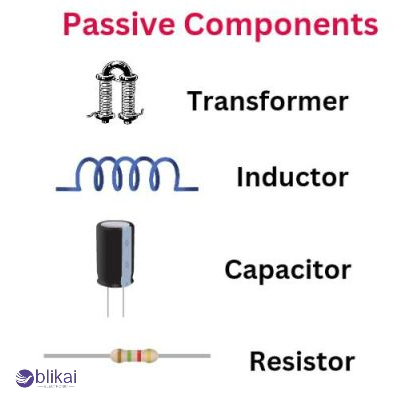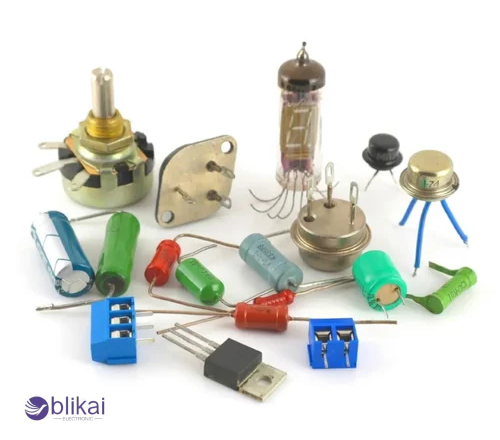Passive Electronic Components in Circuits: Complete Guide
Introduction
Passive electronic components are also basic building blocks in any electronic circuit. Passive components do not produce energy, in contrast to the active components, which depend on an outside power supply to work and can enhance signals. They do not generate electrical energy, but merely store, dissipate, or control electrical energy. Passive components, even though simple, are useful in the functioning of the circuit, signal processing, and energy management. These components are found in consumer electronics and industry machinery, and they make sure that devices are efficient and reliable. Passive components would help any person who is engaged in circuit design, electronics maintenance or system optimization.
Types of Passive Components
Resistors
Passive components include resistors, which are the most commonly used and are used to control current, voltage division, and signal levels. They are available in different forms, and they are either fixed resistors or variable resistors (potentiometers) or precision resistors. Fixed resistors are resistors with a set fixed resistance, whereas variable resistors can be adjusted to a fixed resistance to suit circuit requirements. Where extremely accurate values are required, e.g., in measurement circuits, precision resistors are employed. It is commonly used in analogous circuits as a current-limiting LED, a voltage divider, or biasing transistors.
Capacitors
Capacitors are used to store energy in an electric field and find applications to filter, couple, and decouple signals. They fall into various categories, including ceramic, electrolytic, tantalum and film capacitors. Ceramic capacitors are best used in high-frequency applications, and electrolytic capacitors in bulk storage and smoothing of power supplies. The Tantalum capacitors have consistent performance over smaller sizes, and they are ideal in devices that are portable devices. Capacitors are also important in timing circuits, oscillators and signal processing.
Inductors
Inductors conserve power in a magnetic field when an electrical current is run through them. They are widely utilized in filters, chokes, transformers and in the storage of energy. Inductors resist current change, hence being important in the smoothing of power supplies and suppressing electromagnetic interference (EMI). Globally used in DC-DC converters and RF circuits, inductors are of different types, such as air-core, iron-core, and ferrite-core, depending on the application and required value of inductance.
Transformers
Transformers carry electrical energy between circuits by means of electromagnetic induction. They can upstep, downstep, isolate, and equalize impedance between circuit stages. Transformers play a vital role in power distribution, audio circuits and industrial systems. They are designed in various forms such as isolation transformers, autotransformers and pulse transformers; each of them has its purpose. Their working characteristics are dependent on the core material, winding structure and frequency.

Key Characteristics and Specifications
To choose a proper passive component, one needs to know its specifications. Resistors are characterized in terms of resistance value, tolerance, power rating as well and temperature coefficient. Capacitors are characterized by capacitance, voltage rating, tolerance and equivalent series resistance (ESR). Inductors are characterized based on inductance, current-carrying capacity, saturation current and resistance. Transformers are identified by turns ratio, core type and power rating. Careful reading of datasheets is required to verify that the selected component is suitable for the circuit needs, and would not have failures because of overvoltage, overheating or improper frequency response. Specification matching also enhances reliability and life span.
Applications of Passive Components in Circuits
Signal Conditioning and Filtering
Signal conditioning and signal filtering are commonly performed on passive components. Resistors and capacitors form FC filters to kill noise or average power variation. LC filters are LC networks comprising inductors and capacitors that are used at high frequencies, i.e., RF circuits. These designs assist in sustaining signal integrity within audio, communication and sensor systems.
Power Management
In power regulation, capacitors and inductors play a very crucial part. Capacitors are used to smooth voltage ripples in DC power supplies, and inductors are used to store energy in switching regulators. Transformers convert voltage and isolate circuits in order to guard circuits against surges and spikes. Resistors are used in limiting current and thermal management in use to enable the safe operation of devices when the load changes.
Timing and Oscillation
Timing applications: Resistors and capacitors form RC circuits to form timing circuits (delay circuits, oscillators, pulse generation, etc.). LC circuits create radio frequency and communication devices, which make resonant oscillators. These components allow precise control over circuit timing, frequency, and waveform shaping, making them indispensable in clocks, timers, and signal generators.
Real-World Examples
Passive components are commonplace in modern electronics. In smartphone design, capacitors are used to smooth battery voltage, resistors are used to regulate the brightness of the LEDs, and inductors are used to remove noise. The industrial sensors use passive filters to provide for accurate measurements. The IoT devices, power supplies and the audio amplifiers all require the use of carefully chosen passive components to bring out the best performance.
Tips for Choosing and Using Passive Components
Match Ratings to Requirements: It should always have a selection of components on voltage, current, power and frequency.
Consider Environmental Factors: Temperature, humidity, and vibration can affect performance. Choose components with suitable tolerances and ratings.
Balance Cost and Reliability: Harder quality components can be expensive; however, it will cost a lot but the high quality will result in less maintenance and fewer failures in the long run.
Optimize PCB Layout: Right positioning and routing helps to minimize the level of interference, heat and performance deterioration.
Avoid Common Mistakes: Commonly rated voltage and rated current, and loads which are sensitive to polarity, such as the electrolytic capacitors, should not be used overloaded or of the wrong orientation.
Conclusion
Circuit design is based on passive electronic components, which store energy, manipulate signals and offer protection without external power. They are often lost in the active components, and, however, the importance of them is difficult to undervalue in keeping the stable and reliable operations of any electronic devices. Engineers, hobbyists and technicians require some understanding of these components, their specifications, and use in order to design effective, robust, and cost-efficient circuits. By using a wise mixture of both the passive and active components, the current electronics can provide the highest possible performance, stability and even safety.

FAQ
What is the difference between active and passive components?
Active components are capable of signal amplification and need external power to do this, whereas passive components do not produce power, but only store, dissipate or process energy.
Why are resistors important in circuits?
Resistors are applied to control the flow of current, divide voltage, protect components, and shape signals. Their contribution to stability and safety of the circuit is very critical.
How do capacitors improve circuit performance?
Capacitors store energy, filter noise, smooth voltage and form timing circuits. They find use in both analog and digital.
What factors should I consider when choosing passive components?
Take into account voltage, current, power ratings, frequency, temperature tolerance and environmental conditions. When selection is done properly, it is reliable and efficient.
Can passive components fail?
Oversupply of voltage, current can also cause failure, as well as heat or age. Risks are minimized by the choice of good-quality components and appropriate ratings.
Some images are sourced online. Please contact us for removal if any copyright concerns arise.
Exploring Electronic Components: Innovations and Applications
Exploring Electronic Components(Guide)
TLV3201AQDCKRQ1 Component: Features, Specification and Applications
Surge Suppressor Guide: Protect Electronic Components & Circuits
How to Check a Fuse with a Multimeter [Electronic Components Guide]
Welding Positioner Controls & Electronic Components Guide
How Does a Surge Suppressor Work? Electronic Components Guide
Soft Start Circuit Guide: Components, Working, and Applications
Optoelectronic Components Guide: Types, Uses & Applications
Disadvantages of Solar Energy: Impact on Electronic Components










